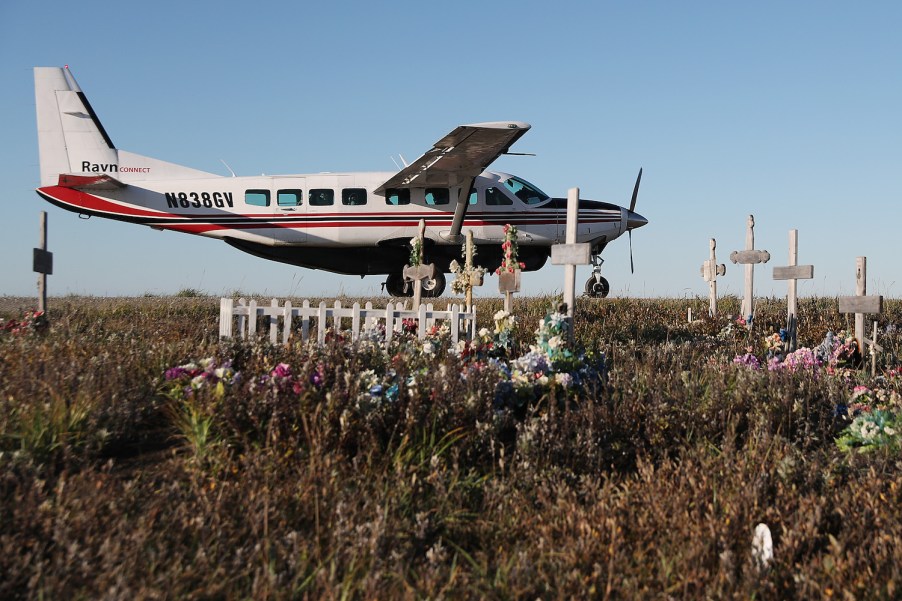
This State Has The Highest Rate of Deadly Plane Crashes in the Country
Flying is part of Alaskan life. More than 80% of Alaskan communities are inaccessible by the state’s road network. Many rural communities rely on airplanes to transport people and deliver mail. Alaska is plagued with 42% of the deadly plane crashes involving commuter, air taxi, and charter flights–nationwide. Yet the state is home to less than 1% of the national population. But some experts argue that many of these deaths are preventable.
Flying is part of Alaskan life

The vast majority of Alaskan communities are inaccessible by road. Airplanes are one of the only ways to transport people and mail to and from countless small towns. The federal government’s Essential Air Service program subsidizes many locals flights in Alaska while the Alaska bypass mail program supports many commuter air routes.
Alaska Airlines offers some limited jet travel in-state. Local airlines such as Ravn Alaska, PenAir, and Frontier Flying Service maintain scheduled routes with medium-sized prop planes. Private pilots who own small bush planes, floatplanes, or seaplanes provide air taxi and charter flights to Alaska’s most remote communities. About one in every 78 Alaskans is a pilot.
Too many deadly plane crashes

According to the Anchorage Daily News, at least 10 fatal plane crashes occurred in Alaska in 2019 alone. That year was far from the exception. In 2018, Alaska suffered nine fatal accidents, eight in 2017, 12 in 2016, and 11 in 2015. Alaska’s 12 fatal 2016 plane wrecks amount to 5.4% of the national total. This is a huge number in a state that is home to less than 1% of the U.S. population.
When you examine the number of plane crashes involving just commuter, air taxi, and charter flights, Alaska’s numbers are even higher–and they are getting worse. Alaska’s KUCB NPR station reports that in the early 2000s, 26% of fatal U.S. crashes involving commuter, air taxi, and charter flights occurred in Alaska. By 2016, that number had climbed to a staggering 42%.
Some might say, if air travel is part of Alaskan life, so are plane crashes. But experts argue that many Alaskan air travel fatalities could be prevented.
Deadly plane crash causes

Many of Alaska’s fatal airplane crashes follow the same pattern. Alaskan Airlines is actually one of the world’s 10 safest airlines. But charter flights to smaller, remote airports with marginal weather can be much more dangerous.
Ketchikan Volunteer Rescue Service President Jerry Kiffer said, “If I had to point to one thing, I would say the weather is the biggest contributing factor.”
Valerie Jokela, an Alaskan native who works with the Federal Aviation Administration explained, “Alaska’s very challenging to fly in…There are mostly mountain ranges that generate their own weather.”
Investing in solutions

Pilots need current information on weather patterns to fly safely. But many parts of Alaska lack the equipment to monitor weather: only half of Alaska’s publically owned airports have the weather reporting equipment required for pilots to take off and land by instrument. The shortage is so bad, some of the small carriers install their own weather stations.
Other carriers are so small that they cannot afford to donate weather stations–each unit costing approximately $90,000. Small carriers or even owner-pilots operate many Alaskan planes. For this reason, the Federal Aviation Administration (FAA) has actually exempted the state from some expensive safety equipment requirements that apply to the lower 48. For example, the Automatic Dependent Surveillance Broadcast systems, or ADS-B prevents plane-to-plane collisions but is not required.
Midair collisions do occur in Alaska and are often fatal. The National Transportation Security Board (NTSB) suggests the FAA require ADS-B in Alaska’s higher-traffic areas. But the technology can cost plane owners thousands. To make matters worse, much of Alaska does not offer the ground stations the ADS-B system needs to communicate with other planes.
Plane owners in Alaska operate with extremely low profit margins, and Alaskan air travel is already highly subsidized by both state and federal governments; tragically, no one is stepping forward to invest the money required to make Alaskan air travel safer.



